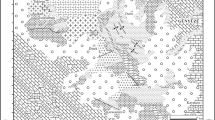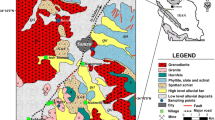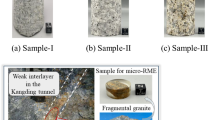Abstract
The weathering degree of rocks has an adverse influence on their strength and deformability characteristics, which in turn influences the industrial uses of rock. The need to develop a weathering index that reveals their mechanical and engineering geological behaviors is thus pertinent to enable the building of more accurate models for forecasting geological hazards. Granite weathering in the Ma On San, Shek Kip Mei and Kwun Tong areas of Hong Kong was studied using scan electron microscope (SEM) images to observe mineral shapes for detailed identification of the weathering degree of completely decomposed granite (CDG). Plagioclase images captured from the SEM were subsequently analyzed and processed with the use of a microstructural image processing system. The results of the analyses indicate that plagioclase, though sensitive to weathering, still remains in CDG and is preserved at different weathering degrees. Hence, it provides a possibility for evaluating the weathering degree more accurately. Thus, a new index referred to as the plagioclase solution degree index is proposed to evaluate the weathering degree of granite.
Similar content being viewed by others
Explore related subjects
Discover the latest articles, news and stories from top researchers in related subjects.Avoid common mistakes on your manuscript.
Introduction
The weathering degree of rock or soil greatly influences its physical, chemical and mechanical characteristics. According to Gokceoglu et al. (2009), weathering has an adverse influence on rock strength and deformability characteristics, which in turn influence the industrial use of rocks. Furthermore, Ceryan (2012) noted that the weathering state and weatherability of rocks are highly important for engineering geology projects and the use of rocks as building material. Thus, a proper understanding of the weathering processes of rocks that ultimately characterize the properties displayed is imperative. Several evaluation methods and indices related to weathering degree have been proposed. The most commonly used methods can be broadly categorized as chemical, mineralogical-petrographical and engineering indices (Gupta and Rao 2001). These include:
-
The rock chemical method consisting of various oxide content ratios, such as the silica to alumina ratio (SiO2/Al2O3), the alumina to potassium-sodium oxide ratio [Al2O3/(K2O + Na2O)] proposed by Ruxton (1968), the alumina to calcium-sodium oxide ratio [Al2O3/(Al2O3 + CaO + Na2O)] by Harnois and Moor (1988), the weathering potential index [100(K2O + Na2O + CaO + MgO − H2O+)/(SiO2 + Al2O3 + Fe2O3 + TiO2 + CaO + MgO + Na2O + K2O)] by Reiche (1943), the weathering product index [100SiO2/(SiO2 + TiO2 + Al2O3)], and the mobile index [(K2O + Na2O + CaO)fresh − (K2O + Na2O + CaO)weathered)/(K2O + Na2O + CaO)fresh] (Irfan 1994).
-
Others include the mineralogical method that encompasses clay mineral content ratio (Lumb and Lee 1975; Gillott 1968), Quartz and feldspar content ratio and mica and vermiculite content ratio (Read et al. 1996); and the physical method comprising rock and soil color, seismic wave transmission (Dearman et al. 1987), acoustic (Dearman 1984), standard penetration value (Huang 1998) and Point loading test value (Xiang 1987).
Several other researchers (Tugrul and Gurpinar 1997; Ceryan et al. 2008b; Rigopoulos et al. 2010; Marques et al. 2010) have proposed mineralogical and micro petrogaphical parameters as the basis for weathering indices in view of their variation with weathering. Kamei et al. (2012) proposed a practical method that eliminates the chemical overlap of petrogenetic effect from the chemical weathering for evaluation of the degree of weathering of varied granitoids over wide areas. Relatively, the rock chemical methods are more commonly used than the other methods, which may not be unconnected to the fact that weathering widely involves chemical factors. However, as indicated by Ceryan (2008), no weathering index would give unequivocal results when applied to the prediction models to assess the mechanical behavior of rock materials. The methods give no uniform chemical index and it thus becomes imperative to find an evaluation method or index suitable to a specific area.
Granite is widely distributed all over the world. In southern China, its distribution area is 30–40 % in Fujian and Guangdong Provinces, and 10–20 % in Guangxi, Hunan and Jiangxi Provinces (Huang 1996). These regions are located in the tropical and subtropical zones which favor Al-enrichment. In Hong Kong, widespread red weathering crust can be seen everywhere, generally between 20 and 40 m deep with the deepest being about 60 m (Irfan 1994). Granite weathering is the primary geologic environment question in these areas, with slide, debris avalanche, and soil and water loss all directly or indirectly due to it. Given that the densest population and economy in China can be found in these areas, the contradiction between geological environment and economic development is prominent, especially in Hong Kong. A more accurate evaluation of granite weathering is of importance, thereby necessitating a study of granite weathering in the Ma On San (MOS), Shek Kip Mei (SKM) and Kwun Tong (KT) areas of Hong Kong. With a better understanding of these areas, we can develop a new weathering index to reveal the mechanical and engineering geological behaviors, and build a more accurate model to forecast geological hazards in completely decomposed granite (CDG) based on the plagioclase solution degree.
Plagioclase solution degree
Plagioclase is not only one of the primary rock-forming minerals of granite, but also one of the more unstable and the easily weathered minerals. With the progression of chemical weathering, plagioclase goes into solution continuously until it disappears from soil. Consequently, the solution state of this mineral can be considered a measure of weathering degree.
Observations from scan electron microscope (SEM) images (Fig. 1) indicate that in the weathering process the appearance of plagioclase changes with two distinctions: (1) its regular long prism-polygon form changes into irregular forms; (2) its internal structure changes from small to large and, poor to well-developed. These two changes often occur at the same time, making it possible to determine the degree of weathering. In this paper, the change of internal voids of plagioclase is analyzed, subsequently followed by a subtle estimation on the weathering degree. Of course, their area can characterize the development state of the internal voids. The concept of “plagioclase solution degree” (N f ), is hereby presented and is expressed as;
where A(i) is the visible void area inside the mineral tested, n is the visible void amount inside the mineral tested and A(m) is the total area of the mineral tested.
Formula (1) is similar to the volume void degree of soil, but it measures the void degree of a single mineral rather than the whole development level of void of a soil mass. The value frame of N f is from 0–100, indicating that the larger the N f , the more the void inside the mineral tested, and also the higher the solution and weathering degrees.
Testing method and process
Scan electron microscope images were used for the observation of mineral shapes because of their suitability. The measurement of N f is based on the plagioclase image captured from SEM. To obtain a statistical result, at least three images were taken from each SEM sample. Analysis and processing of each image was undertaken as follows:
-
1.
A mineral to be tested was chosen and its outline was drawn using a discernible close curve (Fig. 2a).
-
2.
The background (parts besides the mineral tested) was dyed with a transitional color (grayscale) to ensure the detected object stands out (Fig. 2b).
-
3.
The entire void inside the mineral tested was marked out with black (Fig. 2c).
-
4.
The whole area of the mineral tested and the area of each void was measured with microstructural image processing system (MIPS).
-
5.
The total void degree inside the mineral was calculated with formula (1).
All of the test work was undertaken and completed on a MIPS (Hu 1995; Hu et al. 2005), which is a special technique for processing images. The MIPS automatically transfers an original digital image into a ternary image which uses three different image indices to represent the particles, pores and the contact zones, respectively. Most other image processing software packages can only transfer an original digital image into a binary image (Haralick 1979; Smart and Tovey 1988). Furthermore, when an artificial method is used, the workload is very heavy (especially in terms of statistical calculation of the area) and the approach is inconvenient; this can lead to measurement errors because particles and pores may be identified differently in different procedures. The MIPS can be considered as a specialized computer program for quantitative analysis of soil microstructure on SEM images.
Application
In order to investigate the validity of mineral void degree to the weathering degree of soil, samples at different depths were obtained from the CDG section of MOS in Hong Kong. This fresh sampling section made up of eluvial soil of weathered granite is almost perpendicular at a height of 3 m and is located in a building site where slope protection is underway (Fig. 3). Twenty-two samples were obtained at every 10 cm with Φ 8 cm steel ring stroked into the slope by a hammer. To ensure proper preservation, the samples were carefully wrapped with three layers of plastic film and labeled appropriately, indicating the sample number and sampling depth.
At least three SEM images of plagioclase were obtained from each sample after laboratory SEM analysis. The test results displayed in Figs. 4 and 5, respectively, show the changing of plagioclase solution degree (N f ) of all samples with depth (H) and the changing of plagioclase solution degree of the representative image selected with depth.
Test results show that the changing of plagioclase solution degree (N f ) decreases with increasing depth (H). The attenuation of N f with depth depicts an exponential relationship as opposed to a linear relationship, and this can be expressed as:
where a and b are parameters relating to the characters of soil confirmed from test.
The range of the values of plagioclase solution degree is between a–a′ and b–b′. As a whole, it conforms to the exponential attenuation relationship expressed in formula (2). From the whole fitting curve (indicated with dashed line in Fig. 4), the value of a and b are 109.73 and −0.00776, respectively. From Fig. 4, two data groups, A and B, constitute the plagioclase solution degrees, which reflect the different solution degrees. The boundary between depth A and B is line c–c′, at 115 cm. The boundary of solution degree is about 40 % (line d–d′) and can be divided into two parts by a line c–c′, located at 115 cm. Based on these characteristics, the plagioclase solution degree of CDG is partitioned into two genera listed in Table 1.
Using the same method applied to the samples from the MOS area of Hong Kong, two hundred and sixty SEM images of samples obtained from SKM and KT areas in Hong Kong was studied. The results (Fig. 6) show that their plagioclase solution degrees are mostly between 15 and 45 %. The plagioclase solution degree in SKM (with a mean value of 42.1 %) is higher than that of KT (with a mean value of 24.7 %). Thus, it is reasonable to conclude that the soils from SKM possess lower strength when compared to those from KT.
As indicated by Best (2003), it must be noted that plagioclases in igneous rocks are normally zoned from calcic cores to more sodic rims. Dissolution of plagioclases with weathering depends not only on its Ca–Na ratio, but also on the solvent compositions such as CO2, SO2, and pH in rainfall and watershed (Apollaro et al. 2009; Schiavon 2007; White et al. 2001). Therefore, solubility of a plagioclase grain in granitoids is probably different from core to rim. This diversity may be a cause of the broad trend of plagioclase solution degree with depth on Fig. 4. Furthermore, the rocks in a granitic intrusion exhibit considerable chemical variation arising from their magmatic difference (Kamei et al. 2012). The Ca–Na ratio of plagioclases in a granitic intrusion is not homogeneous. For example, the Ca content of plagioclase generally decreases with the granitoid variation from basic to acidic (Clarke 1992). This chemical variation of plagioclases in a granitic intrusion may result in the wide variation of the plagioclase solution degree of both the SKM and KT intrusions (Fig. 6) and the variation strongly affects the chemical evolution with subsequent weathering.
Conclusions
For CDG, it is important to evaluate the grade difference of weathering degree. Only the grade difference can determine what geotechnical measures should be selected. Studies in the MOS, SKM and KT areas of Hong Kong suggest that the plagioclase solution degree is a sensitive index that can provide the graduation of weathering in CDG, although at only two grades. If a section is deeper and samples are increased, more grades of weathering can be identified by the index. Moreover, weathering depends on many factors. Even in an area, a weathering index is not universal. It is not expected that the plagioclase solution degree is applicable to all granite weathering areas, but its potential to divide the weathering grade should be stressed. Especially the introduction of SEM images seems to be able to open up new possibilities for refining the weathering grade.
Conclusively, a study of granite weathering in Hong Kong has shown that plagioclase (which is sensitive to weathering) remains in CDG and is preserved at different weathering degrees. This sensitivity provides a possibility for evaluating the weathering degree accurately using a new weathering index based on plagioclase solution degree.
References
Apollaro C, Accornero M, Marini L, Barca D, De Rosa R (2009) The impact of dolomite and plagioclase weathering on the chemistry of shallow groundwaters circulating in a granodiorite-dominated catchment of the Sila Massif (Calabria, Southern Italy). Appl Geochem 24:957–979
Best MG (2003) Igneous and metamorphic petrology. Oxford Blackwell Science, Malden, MA, p 729
Ceryan S (2008) New chemical weathering indices for estimating engineering properties of rocks: a case study from Kürtün Granodiorite NE Turkey. Turk J Earth Sci 17:187–207
Ceryan S (2012) Weathering indices for assessment of weathering effect and classification of weathered rocks: a case study from NE Turkey, earth sciences, Dar IA (ed), ISBN: 978-953-307-861-8, InTech, available from: http://www.intechopen.com/books/earth-sciences/weathering-indices-for-assessment-of-weathering-effect-and-classification-of-weathered-rocks-a-case
Ceryan S, Tudes S, Ceryan N (2008) A new quantitative weathering classification for igneous rocks. Environ Geol 55:1319–1336
Clarke DB (1992) Granitoid rocks. Chapman and Hall, London, p 283
Dearman WR (1984) State of weathering. The search for a rational approach. Site investigation practice: assessing BS 5930. In Hawkins AB (ed). Geological Society Engineering Geology Special Publication
Dearman WR, Turk N, Irfan TY, Rowshanei H (1987) Detection of rock material variation by sonic velocity zoning. Bull Int Assoc Eng Geol 35:3–8
Gillott JE (1968) Clay in engineering geology. Elsevier, Amsterdam
Gokceoglu C, Zorlu K, Ceryan S, Nefeslioglu HA (2009) A comparative study on indirect determination of degree of weathering of granites from some physical and strength parameters by two soft computing techniques. J Mater Charact 60:1317–1327
Gupta AS, Rao KS (2001) Weathering indices and their applicability for crystalline rocks. Bull Eng Geol Environ 60:201–221
Haralick RM (1979) Statistical and structural approaches to texture. Proc IEEE 67:786–804
Harnois L, Moor JM (1988) Geochemistry and origin of the Ore Chimney Formation, a transported paleoregolith in the Grenville Province of Southern Ontario, Canada. Chem Geol 69:267–289
Hu RL (1995) Quantitative model and engineering geologic characteristics of microstructures of viscous soil. Geological Publishing House, Beijing (in Chinese)
Hu RL, Yue ZQ, Tham LG, Wang LC (2005) Digital image analysis of dynamic compaction effects on clay fills. J Geotech Geoenviron Eng 131:1411–1422
Huang Z (1996) The red weathering crest in southward of China. China Ocean Press, Beijing (in Chinese)
Huang Z (1998) Application of SPT in eluvial soil of granite. Mod Surv 3:2–19 (in Chinese)
Irfan TY (1994) Mineralogy and fabric characterization and classification of weathered granitic rocks in Hong Kong. GEO report No.41, GEO, Civil Engineering Department, Hong Kong
Kamei A, Fukushi K, Takagi T, Tsukamoto H (2012) Chemical overprinting of magmatism by weathering: a practical method for evaluating the degree of chemical weathering of granitoids. Appl Geochem 27(3):796–805
Lumb P, Lee CF (1975) Clay mineralogy of the Hong Kong soils. Proceedings of the Fourth Southeast Asian Conference on Soil Engineering, Kuala Lumpur, pp 41–50
Marques EAG, Barroso EV et al (2010) Weathering zones on metamorphic rocks from Rio de Janeiro—Physical, mineralogical and geomechanical characterization. Eng Geol 111(1–4):1–18
Read G, Rob AK, James R (1996) Development of a feldspar weathering index and its application to a buried soil chronosequence in southeastern England. Geoderma 74(3–4):267–280
Reiche P (1943) Graphic representation of chemical weathering. J Sediment Petrol 13:58–68
Rigopoulos I, Tsikouras B, Pomonis P, Hatzipanagiotou K (2010) The influence of alteration on the engineering properties of dolerites: the examples from the Pindos and Vourinos ophiolites (northern Greece). Int J Rock Mech Min Sci 47:69–80
Ruxton BP (1968) Measures of the degree of chemical weathering of rocks. J Geol 76:518–527
Schiavon N (2007) Kaolinisation of granite in an urban environment. Environ Geol 52(2):399–407
Smart P, Tovey NK (1988) Theoretical aspects of intensity gradient analysis. Scanning 8:75–90
Tuğrul A, Gurpınar O (1997) The effect of chemical weathering on the engineering properties of Eocene basalts in northeastern Turkey. Environ Eng Geosci 3:225–234
White AF, Bullen TD, Schulz MS, Blum AE, Huntington TG, Peters NE (2001) Differential rates of feldspar weathering in granitic regoliths. Geochim Cosmochim Acta 65:847–869
Xiang G (1987) Point loading test—an express method to study the weathering zone of rock. J Chengdu Coll Geol 2:2–145 (in Chinese)
Acknowledgments
The research reported in this paper was supported by the National Natural Science Foundation of China (No. 41330643, No. 41072226 and No. 41030750).
Author information
Authors and Affiliations
Corresponding author
Rights and permissions
About this article
Cite this article
Hu, R., Oyediran, I.A., Gao, W. et al. “Plagioclase solution degree index”: a new index to evaluate the weathering degree of granite. Bull Eng Geol Environ 73, 589–594 (2014). https://doi.org/10.1007/s10064-013-0510-7
Received:
Accepted:
Published:
Issue Date:
DOI: https://doi.org/10.1007/s10064-013-0510-7










